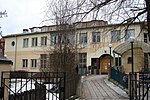Bror Hjorths Hus
1978 establishments in SwedenArt museums and galleries in SwedenArt museums established in 1978European art museum and gallery stubsMuseums in Uppsala ... and 1 more
Swedish museum stubs

Bror Hjorths Hus is a museum located in Uppsala, Sweden. The museum is housed in the former studio of sculptor and painter Bror Hjorth (1894–1968). Hjorth's villa was designed by architect Sten Hummel-Gumaelius (1906-1986). The building was built in 1943 and was for 25 years both the home and studio of Bror Hjorth.The museum has a large collection of Hjorth's work. The former residence and studio are filled with paintings, sculptures, reliefs and drawings as well as preliminary works and sketches for the artist's many public assignments. The museum opened in 1978. In the mid-1990s, the museum was expanded with an exhibition hall designed by architect Bengt Löfberg.
Excerpt from the Wikipedia article Bror Hjorths Hus (License: CC BY-SA 3.0, Authors, Images).Bror Hjorths Hus
Norbyvägen, Uppsala Kungsgärdet
Geographical coordinates (GPS) Address Website External links Nearby Places Show on map
Geographical coordinates (GPS)
| Latitude | Longitude |
|---|---|
| N 59.849444444444 ° | E 17.620277777778 ° |
Address
Bror Hjorths Hus
Norbyvägen 26
752 38 Uppsala, Kungsgärdet
Sweden
Open on Google Maps










